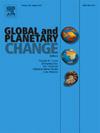Climate variability in a 3.8 Ma old sedimentary record from the hyperarid Atacama Desert
IF 4
1区 地球科学
Q1 GEOGRAPHY, PHYSICAL
引用次数: 0
Abstract
The hyperarid Atacama Desert is one of the driest and oldest deserts on Earth, rendering it a valuable climate archive. However, unraveling its past climate is particularly challenging and the few studied paleoclimate records of the region reveal strong temporal and spatial variabilities. To enhance our understanding of these dynamics we investigated a sedimentary record in the Yungay valley located in the southern hyperarid Atacama Desert. We employed paleomagnetic and radiocarbon dating, and for the first time for Atacama Desert sediments, a meteoric 10Be/9Be based method for determining the depositional age. The respective 4.20 m deep profile comprises a lower alluvial fan deposit with a maximum age of 3.8 ± 0.8 Ma, and an upper 1.84 m thick clay pan deposit that has accumulated over the last 19 ka. Different proxies including grain size, salt concentration, and elemental composition indicate an aridity increase around 2.3 Ma ago and repeated dry and wet phases during the late Pleistocene and the Holocene. The latter climatic shifts can be assigned to variabilities of the South American Summer Monsoon and El Niño Southern Oscillation with moisture sources from the Atlantic and the Pacific Ocean, respectively. This study provides deeper insights into the heterogeneous climate of the hyperarid Atacama Desert and underlines the importance of interdisciplinary investigations to decipher climate systems and their effect on potential habitable regions in such an extreme environment.
超干旱阿塔卡马沙漠 3.8 马年沉积记录中的气候变异性
极度干旱的阿塔卡马沙漠是地球上最干旱和最古老的沙漠之一,因此是一个宝贵的气候档案库。然而,揭示其过去的气候特别具有挑战性,该地区为数不多的古气候记录显示出强烈的时空变异性。为了加深对这些动态变化的了解,我们研究了位于阿塔卡马沙漠南部极干旱地区的永盖山谷的沉积记录。我们采用了古地磁和放射性碳测年法,并首次在阿塔卡马沙漠沉积物中采用了基于陨石 10Be/9Be 的方法来确定沉积年龄。4.20 米深的剖面包括下部冲积扇沉积层和上部 1.84 米厚的粘土沉积层,前者的最大年龄为 3.8 ± 0.8 Ma,后者是在过去 19 ka 年中累积而成的。不同的代用指标(包括粒度、盐浓度和元素组成)表明,大约在 2.3 Ma 前干旱加剧,晚更新世和全新世期间反复出现干湿阶段。后者的气候转变可归因于南美洲夏季季风和厄尔尼诺南方涛动的变化,其水汽来源分别来自大西洋和太平洋。这项研究使人们更深入地了解了阿塔卡马沙漠的多变气候,并强调了跨学科研究对于破解气候系统及其对这种极端环境中潜在宜居地区的影响的重要性。
本文章由计算机程序翻译,如有差异,请以英文原文为准。
求助全文
约1分钟内获得全文
求助全文
来源期刊

Global and Planetary Change
地学天文-地球科学综合
CiteScore
7.40
自引率
10.30%
发文量
226
审稿时长
63 days
期刊介绍:
The objective of the journal Global and Planetary Change is to provide a multi-disciplinary overview of the processes taking place in the Earth System and involved in planetary change over time. The journal focuses on records of the past and current state of the earth system, and future scenarios , and their link to global environmental change. Regional or process-oriented studies are welcome if they discuss global implications. Topics include, but are not limited to, changes in the dynamics and composition of the atmosphere, oceans and cryosphere, as well as climate change, sea level variation, observations/modelling of Earth processes from deep to (near-)surface and their coupling, global ecology, biogeography and the resilience/thresholds in ecosystems.
Key criteria for the consideration of manuscripts are (a) the relevance for the global scientific community and/or (b) the wider implications for global scale problems, preferably combined with (c) having a significance beyond a single discipline. A clear focus on key processes associated with planetary scale change is strongly encouraged.
Manuscripts can be submitted as either research contributions or as a review article. Every effort should be made towards the presentation of research outcomes in an understandable way for a broad readership.
 求助内容:
求助内容: 应助结果提醒方式:
应助结果提醒方式:


